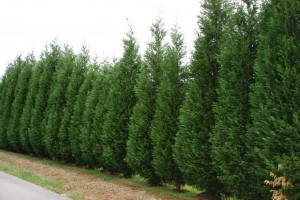Leyland cypress (x Cupressocyparis leylandii) is a tall, fast growing evergreen tree or shrub. Many are planted as privacy screens. Ask yourself, should you really plant a 50 foot barrier between you and your neighbor(s)?
In the Southern Appalachian region (USDA hardiness zones 6 and 7), there are shorter and better evergreen choices. In the 12-16 foot category:
Boxwood (Buxus spp. and hybrids)
Plum yew (Cephalotaxus harringtonia) ‘Fastigiata’
Hinoki cypress (Chamaecyparis obtusa)
Japanese falsecypress (Chamaecyparis pisifera)
Dwarf Burford holly (Ilex cornuta ‘Dwarf Burford’)- clipped
Inkberry (Ilex glabra)
Foster holly (Ilex x attenuata)- clipped
American holly (Ilex opaca)- clipped
Nellie R. Stevens holly (Ilex x ‘Nellie R. Stevens’)- clipped
Skip laurel (Prunus laurocerasus ‘Schipkaensis’)
Yew (Taxus spp.)- upright or fastigiate forms
Eastern arborvitae (Thuja occidentalis)
Leatherleaf viburnum (Viburnum rhytidophyllum)
Prague viburnum (Viburnum x pragense)
Leyland cypress is susceptible to three serious canker diseases, in which pruning is the principal curative remedy. Leyland is also susceptible to bagworms. Their enormous growing height makes pesticide spraying and pruning options almost impractable and costly.
From the start, don’t plant leylands closer than 12 feet apart (recommend 16 feet spacing). Plants will touch within 4 years after planting. During the first three summers, young leylands require deep watering as they’re not drought tolerant. A 2-3 inch mulching depth in the row aids in conserving soil moisture.


 Posted in
Posted in 

Re: Cypress Leylandi
After a winter with more than usual rain and snow, two of my leylandii were left leaning at a 45 degree angle. Too large to right, we removed the top 1/2 of each tree – thinking we would remove and replace in the spring. Come spring they promptly filled out and I would not remove them for all the rice in China. They have become a dense (inpenetrable) hedge. We have topped the rest of our leylandii to encourage this beautiful aberration. Added benefit: a more manageable barrier.
BTW, unfortunately I do need a 50′ barrier between me and my Mc Mansion neighbor. We planted leylandii on a slightly elevated knoll so a 20′ barrier works for us. Don’t dismiss this beautiful tree too quickly.
I hope that Leyland cypress works well for you. No question about their incredible speed of growth which is a major asset to many gardeners. In the mid-South area (Tennessee, NC and VA, we have experienced severe cankering (disease) with no chemical remedy available. Good air circulation around your landscape plus summer irrigation during severe dry spells also helps slow disease onset…Hugh